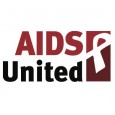This blog post is by Whitney Thomas, the policy and communications associate at AIDS United.
Throughout my life, I have been amazed at how the history of events is often passed down through the storytelling that happens around a holiday dinner table. I’m sure many of us have fond memories of learning about the lives of our loved ones through these types of storytelling events. We learn about our elder’s joys, triumphs and hopefully listen well enough to learn from their failures. These discussions give us the knowledge and wisdom of those who came before us.
This is something that the queer community and those deeply impacted by HIV do not necessarily have in the same way.
I remember, when I was about 16, I saw this image of some of the original members of the San Francisco Gay Men’s Chorus. Taken in 1993, the image shows a chorus on a set of risers, with most members dressed in black and facing away from the camera, with only seven men dressed in white facing the camera. This is to showcase the loss of life from HIV/AIDS. This chorus only had seven of its 115 original members still living, from the group that started in 1989.
I think of this image often and of all the stories that were lost during this time. An entire generation and all subsequent generations of queer individuals have been deeply impacted by HIV, and yet the movement to end the epidemic and secure civil rights for LGBTQ individuals is ongoing. We see state legislatures continually attacking the rights of transgender individuals and the Equality Act not yet passed by the Senate.
The movement to end the HIV epidemic employs me, as someone who was born 18 years into this epidemic. In fact, on the day I was born, Donna Shalala, secretary of the U.S. Department of Health and Human Services, determined that needle exchange programs were effective and did not encourage the use of illegal drugs. Yet, in the face of this information that could save countless more lives, no administration in my lifetime has lifted the ban on using federal funds for syringe exchanges.
For context, I turn 23 this month.
In order to end HIV, we need to ensure that the movement has the longevity required to put a stop to an epidemic that is older than what we even consider to be a youth advocate. We need to intentionally ensure we are including youth voices in this fight.
This involves taking the time to listen to your youth advocates. Many of us see a vision for our future that ensures equitable care for everyone. This generation of youth advocates is more diverse, more of them are LGBTQ, more racial justice-focused and above all, this next generation of youth advocates is expected to be one of the most disruptive in terms of advancing social change. Take time to tell us about your history in the fight to end HIV, but be just as willing to give us an equal seat at the table.
In honor of the month’s National Youth HIV/AIDS Awareness Day, I encourage all of those who have been in this movement since the beginning to take time to talk with youth advocates in your area. Share your story, your experiences and the fights you had to endure to receive the treatment you deserve. As more and more elders in this movement pass, do not allow more of the history of this movement to disappear with those who were lost too soon.
Instead, let your stories fuel the next generation of advocates to finish out what so many of you started. Help educate and elevate the youth advocates in your communities.
For more information about how you can help #StopHIVTogether, click here.








Comments
Comments